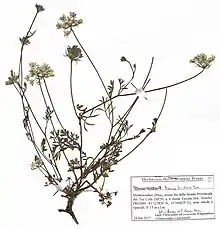Daucus broteri
Daucus broteri, commonly known as Brotero's carrot,[3] is a wild relative of Daucus carota that can be found across the northeast Mediterranean and the Middle East.[4] It grows in cultivated and plantation-type land.[1]
| Daucus broteri | |
|---|---|
 | |
| Flower umbel of Daucus broteri | |
| Scientific classification | |
| Kingdom: | Plantae |
| Clade: | Tracheophytes |
| Clade: | Angiosperms |
| Clade: | Eudicots |
| Clade: | Asterids |
| Order: | Apiales |
| Family: | Apiaceae |
| Genus: | Daucus |
| Species: | D. broteri |
| Binomial name | |
| Daucus broteri Ten. (1830) | |
| Synonyms[2] | |
| |
Description

Specimen of Daucus broteri showing the stem, leaves, and flowers
Daucus broteri forms disc-shaped bunches of white flowers called Umbels that bloom between April and August.[5] It grows up to 10 to 30 cm with an upright stem that's heavily branched at the base with a single, long taproot and leaves that are bi-pinnate.
References
- The IUCN Red List of Threatened Species. "Daucus broteri". IUCN Red List of Threatened Species: e.T172136A6834136. Retrieved 22 February 2022.
- "broteri", Royal Botanical Gardens Kew, retrieved 22 February 2022
- "Daucus broteri(DAUBR)", EPPO Global Database, retrieved 21 February 2022
- "broteri distribution", Royal Botanical Gardens Kew, retrieved 22 February 2022
- "broteri phenology", Flora of Israel Online, retrieved 22 February 2022
 Data related to Daucus broteri at Wikispecies
Data related to Daucus broteri at Wikispecies Media related to Daucus broteri at Wikimedia Commons
Media related to Daucus broteri at Wikimedia Commons
This article is issued from Wikipedia. The text is licensed under Creative Commons - Attribution - Sharealike. Additional terms may apply for the media files.
